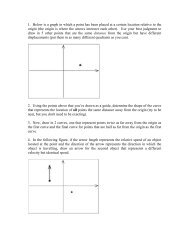Jamming, Avalanches, and Unpredictability: Nonlinear Dynamics ...
Jamming, Avalanches, and Unpredictability: Nonlinear Dynamics ...
Jamming, Avalanches, and Unpredictability: Nonlinear Dynamics ...
You also want an ePaper? Increase the reach of your titles
YUMPU automatically turns print PDFs into web optimized ePapers that Google loves.
<strong>Jamming</strong>, <strong>Avalanches</strong>, <strong>and</strong><br />
<strong>Unpredictability</strong>: <strong>Nonlinear</strong> <strong>Dynamics</strong> <strong>and</strong><br />
Complexity in Granular Flows<br />
Brian Utter
Granular Materials<br />
• Large number of individual solid grains, repulsive<br />
contact forces<br />
• Large energy loss (inelastic collisions or friction)<br />
• Ordinary temperature (i.e.˚C) is unimportant.<br />
Energy must be put in to change system (“out-ofequilibrium”).
<strong>Jamming</strong>, <strong>Avalanches</strong>, <strong>and</strong><br />
<strong>Unpredictability</strong>: <strong>Nonlinear</strong> <strong>Dynamics</strong> <strong>and</strong><br />
Complexity in Granular Flows<br />
Brian Utter
Granular Materials in Nature<br />
• avalanches, l<strong>and</strong>slides<br />
• sinkholes<br />
• dunes<br />
• space applications<br />
www.avalanche.org
Granular Materials in Industry<br />
QuickTime <strong>and</strong> a<br />
decompressor<br />
are needed to see this picture.<br />
• processing grains<br />
<strong>and</strong> powders<br />
• silos/<br />
pharmaceuticals/<br />
construction<br />
• metamaterials/<br />
energy absorption
“Soft Condensed Matter”<br />
QuickTime <strong>and</strong> a<br />
decompressor<br />
are needed to see this picture.<br />
QuickTime <strong>and</strong> a<br />
decompressor<br />
are needed to see this picture.<br />
QuickTime <strong>and</strong> a<br />
decompressor<br />
are needed to see this picture.<br />
Granular materials is<br />
one of a bunch of<br />
related systems:<br />
polymers, colloids,<br />
foams, suspensions,<br />
…<br />
This is soft<br />
condensed matter<br />
(“squishy physics”)<br />
QuickTime <strong>and</strong> a<br />
decompressor<br />
are needed to see this picture.
A couple unusual properties<br />
QuickTime <strong>and</strong> a<br />
YUV420 codec decompressor<br />
are needed to see this picture.<br />
granular eruptions: also available at http://www.youtube.com/watch?v=YfYPJZCSI-E
These systems sometimes behave like solids, or<br />
liquids, or gases (or something else), but…<br />
There are no general equations for granular flow<br />
like we have for gases or liquids.<br />
We underst<strong>and</strong> the really basic equations between two grains<br />
(friction, collisions, energy loss, …), so what’s the problem?
An Analogy: The Pendulum<br />
What makes the pendulum come back to center?<br />
We can write an equation for the amount of time it takes for the<br />
pendulum to swing back <strong>and</strong> forth…<br />
…if we assume that the pendulum is not<br />
pushed back too far from equilibrium.<br />
…the more you push the pendulum, the<br />
stronger the pull back to the center (linear).
An Analogy: The Pendulum<br />
But what if you keep pushing?<br />
It goes over the top…<br />
<strong>Nonlinear</strong> <strong>Dynamics</strong>: When the response of the system is not<br />
proportional to how hard you push it.
An Analogy: The Pendulum<br />
And what if you stick two pendulums together?<br />
http://www.maths.tcd.ie/~plynch/SwingingSpring/doublependulum.html<br />
Chaos: Unpredictable long-term behavior.<br />
Complex System: When simple building blocks combine to<br />
produce complicated behavior.
But is this just a strange physics toy?<br />
Chaos was discovered in weather simulations.<br />
QuickTime <strong>and</strong> a<br />
decompressor<br />
are needed to see this picture.<br />
(You’ll never have a good 10-day weather forecast!)
But is this just a strange physics toy?<br />
Climate models are non-linear:<br />
QuickTime <strong>and</strong> a<br />
decompressor<br />
are needed to see this picture.<br />
(There can be unexpected changes, like tipping points… where it<br />
behaves like a seesaw that suddenly tips over to the other side.)
Complications<br />
(a few anyway)<br />
• Complex system (interaction of<br />
many simple parts) / history<br />
dependence<br />
• Complicated force network<br />
• Narrow regions where grains<br />
flow (“Shear b<strong>and</strong>s” )<br />
• Lots of energy lost / gets<br />
stuck or jammed
Complications<br />
(a few anyway)<br />
<br />
• Complex system (interaction of<br />
many simple parts) / history<br />
dependence<br />
• Complicated force network<br />
• Narrow regions where grains<br />
flow (“Shear b<strong>and</strong>s” )<br />
• Lots of energy lost / gets<br />
stuck or jammed<br />
Friction can keep increasing<br />
until something slips. What<br />
happens depends on how the<br />
pile was put together.
Complications<br />
(a few anyway)<br />
• Complex system (interaction of<br />
many simple parts) / history<br />
dependence<br />
<br />
• Complicated force network<br />
• Narrow regions where grains<br />
flow (“Shear b<strong>and</strong>s” )<br />
QuickTime <strong>and</strong> a<br />
YUV420 codec decompressor<br />
are needed to see this picture.<br />
• Lots of energy lost / gets<br />
stuck or jammed
Complications<br />
(a few anyway)<br />
• Complex system (interaction of<br />
many simple parts) / history<br />
dependence<br />
• Complicated force network<br />
QuickTime <strong>and</strong> a<br />
YUV420 codec decompressor<br />
are needed to see this picture.<br />
<br />
• Narrow regions where grains<br />
flow (“Shear b<strong>and</strong>s” )<br />
• Lots of energy lost / gets<br />
stuck or jammed<br />
shear
Complications<br />
(a few anyway)<br />
• Complex system (interaction of<br />
many simple parts) / history<br />
dependence<br />
• Complicated force network<br />
• Narrow regions where grains<br />
flow (“Shear b<strong>and</strong>s” )<br />
<br />
• Lots of energy lost / gets<br />
stuck or jammed
<strong>Jamming</strong><br />
How do these things unstuck?<br />
shake<br />
push<br />
harder<br />
decrease<br />
density
Hopper<br />
QuickTime <strong>and</strong> a<br />
YUV420 codec decompressor<br />
are needed to see this picture.
<strong>Avalanches</strong><br />
QuickTime <strong>and</strong> a<br />
YUV420 codec decompressor<br />
are needed to see this picture.
<strong>Avalanches</strong><br />
50<br />
Angle (degrees)<br />
45<br />
40<br />
35<br />
Avalanche<br />
Size of Avalance (degress)<br />
30<br />
25<br />
20<br />
15<br />
10<br />
30<br />
1<br />
0.1<br />
200 210 220 230 240 250 260 270 280<br />
Probability<br />
Time (s)<br />
0.01<br />
0.001<br />
5<br />
0<br />
0 5 10 15 20 25<br />
Previous Build-Up (degrees)<br />
0.0001<br />
1 10 100<br />
Size of Avalanche (degrees)
<strong>Avalanches</strong><br />
50<br />
Angle (degrees)<br />
45<br />
40<br />
35<br />
30<br />
200 210 220 230 240 250 260 270 280<br />
Time (s)<br />
What can we learn?<br />
-- we need statistics to describe this process<br />
-- the number of small/large avalanches looks like similar things<br />
(earthquakes) <strong>and</strong> every once in a while, the big one can hit<br />
-- large avalanches are more likely if there hasn’t been one for a while<br />
-- adding energy can trigger an avalanche, but can also make the pile<br />
stronger<br />
Segregation (separation of particles by<br />
shape, size, density, etc.) also occurs!
Particle Trajectories<br />
Diffusion, coordinated motion, force chains, etc.<br />
QuickTime <strong>and</strong> a<br />
YUV420 codec decompressor<br />
are needed to see this picture.<br />
QuickTime <strong>and</strong> a<br />
YUV420 codec decompressor<br />
are needed to see this picture.<br />
QuickTime <strong>and</strong> a<br />
YUV420 codec decompressor<br />
are needed to see this picture.
“Multiphase” Flow<br />
Things get more complicated when you add a fluid to the mixture.<br />
You can get quick s<strong>and</strong> (where it becomes much easier to move through the<br />
grains with lubrication provided by the water).<br />
But you can also get shear thickening: when stirring a material (shear) causes<br />
it to become stronger (thickening). The grains & force chains to resist the<br />
motion.<br />
QuickTime <strong>and</strong> a<br />
decompressor<br />
are needed to see this picture.
One more unusual property<br />
QuickTime <strong>and</strong> a<br />
YUV420 codec decompressor<br />
are needed to see this picture.<br />
clustering: also available at http://pof.tnw.utwente.nl/3_research/files/clustering.mpg
And one potential application…<br />
QuickTime <strong>and</strong> a<br />
decompressor<br />
are needed to see this picture.<br />
QuickTime <strong>and</strong> a<br />
decompressor<br />
are needed to see this picture.<br />
Robotic gripper:<br />
http://www.youtube.com/watch?v=bFW7VQpY-Ik
Where We Are…<br />
Grains are simple <strong>and</strong> ubiquitous, but granular flows are complex<br />
<strong>and</strong> unpredictable… <strong>and</strong> poorly understood.
















